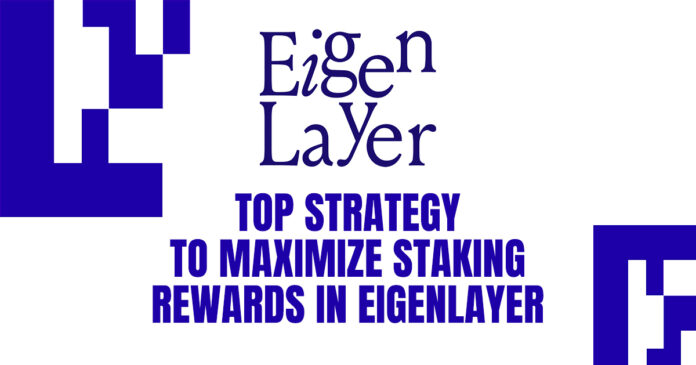Ethereum Restaking and Maximizing Staking Rewards in EigenLayer. Ethereum restaking has been gaining massive traction recently, with EigenLayer leading the charge in this narrative, offering lucrative avenues for users.
In this article, we’ll delve into the concept of Ethereum restaking and uncover strategies for maximizing staking rewards.
What is Ethereum Restaking?
Staking entails locking a quantity of ETH to improve the network’s security. Participants in the crypto space stake ETH to earn rewards. Presently, the Ethereum protocol mandates a minimum deposit of 32 ETH, roughly equivalent to $95,000 at the time of this writing.
Alternatively, individual users can tap into specialized services that aggregate staking capital from ETH holders worldwide, thus lowering the barriers to entry. Additionally, DeFi staking services offer liquid staking tokens (LST) in exchange for locked ETH, allowing users to delve into DeFi opportunities while staking.
Source: Staking Rewards
Currently, a substantial portion of ETH is staked through liquid staking services like Lido or Rocket Pool, either in pools or by individual holders.
Meanwhile, Ethereum restaking, a concept introduced by EigenLayer, enables stakers on the Ethereum network to utilize their staked ETH to secure other protocols and earn extra rewards without needing to unstake their tokens.
There are two primary steps for individuals interested in restaking: activating restaking through EigenLayer and then delegating to an operator. These operators oversee the necessary hardware for other protocols, called Actively Validated Services (AVSs) on EigenLayer.
Moreover, EigenLayer restaking supports both ETH and LSTs such as stETH (Lido) or rETH (RocketPool). Undoubtedly, restaking represents an exciting new development for the Ethereum ecosystem. However, users must understand the opportunity and carefully assess any protocols they interact with.
How Eigenlayer Works And Ways To Restake
At the core of EigenLayer lies pooled security through restaking, where multiple parties combine their staked ETH to enhance security. This pooling is achieved through two ways: native restaking and liquid restaking.
Native restaking caters to advanced users and involves operating one’s own Ethereum validator and depositing regular ETH into what’s known as an “EigenPod.” On the other hand, liquid restaking is notably simpler, requiring the depositing of LST like Coinbase cbETH, Rocket Pool rETH, or Lido stETH into EigenLayer.
The overarching vision is for EigenLayer to operate as a restaking marketplace, granting depositors the autonomy to select which projects or modules they wish to support. This approach empowers restakers to make decisions aligned with their interests, risk tolerance, and potential rewards.
Source: DefiLlama
Besides, the protocol’s Total Value Locked (TVL) has experienced a significant surge in recent months, establishing itself as the third-largest DeFi protocol in 2024 with over $7.62 billion in TVL. It represents a massive 7x increase since the beginning of 2024. To provide further context, it’s noteworthy that EigenLayer wasn’t even listed among the top 10 DeFi projects a month ago.
When And How Can I Deposit on EigenLayer?
Currently, the feature to deposit on EigenLayer using LSTs is not yet active; however, you can make deposits by establishing an EigenPod. Many anticipate the subsequent step—delegating to an operator— to be enabled sometime within this quarter. Additionally, we expect several AVSs live for operators to run then.
Besides, the capability to delegate and the availability of a handful of AVSs are prerequisites for introducing further restaking offerings, such as off-chain fund vehicles, new LRT protocols, and enhanced integration with custodians, wallets, and other service providers.
Restaking LSTs has been paused as we gear up for the Operator & @eigen_da mainnet launch, with an impressive 2.45+ million ETH restaked and ready.
We're excited to further our collaboration with our vibrant community, driving forward Infinite Sum Games. Stay tuned! ♾️
— EigenLayer (@eigenlayer) February 9, 2024
At the time of compiling this guide, deposits for native restaking were uncapped on EigenLayer, while deposits for liquid restaking remained temporarily paused.
That said, once deposits are fully open, the process for participation is straightforward. When the feature is live, you can follow these steps:
Step 1: EigenLayer currently supports a variety of LSTs, including rETH, osETH, wBETH, stETH, swETH, oETH, ETHx, cbETH, sfrxETH, lsETH, ankrETH, and mETH. If you haven’t already, acquire your preferred LST and transfer the token into your wallet.
Step 2: Navigate to app.eigenlayer.xyz and connect your wallet. Then, select the asset you wish to start restaking with.
Source: Eigenlayer
Step 3: In the provided interface, specify the amount you intend to deposit into EigenLayer. Complete the approval and final authorization transactions with your wallet to initiate restaking.
Source: Eigenlayer
Once you’ve completed these steps, you can monitor all your deposits from the main EigenLayer app page. Additionally, you can withdraw funds at your convenience using the “Unstake” button in the deposit interfaces. However, please note that EigenLayer currently imposes a 7-day withdrawal delay, so your funds will take a week to transfer to your wallet.
How to Create an EigenPod?
An EigenPod is a smart contract overseen by users, specifically crafted to facilitate the EigenLayer protocol’s monitoring and management of balance and withdrawal statuses. Consensus Layer (CL) rewards and stake transit through the EigenPod before reaching the restaker’s account. This setup grants EigenLayer the authority to impose penalties for misbehavior.
Anyhow, users can assign any number of validators to a single EigenPod. However, it’s important to note that an Ethereum address can deploy only one EigenPod. Essentially, the address responsible for deploying an EigenPod assumes ownership of the contract, obtaining authorization for restaking and withdrawal operations. It’s important to note that the ownership of an EigenPod is non-transferable. Here’s how to get started:
Step 1: Navigate to app.eigenlayer.xyz and connect your wallet, ensuring connection to the Ethereum mainnet.
Source: Eigenlayer
Step 2: Click on “Create EigenPod” and confirm this action in your wallet.
Source: Eigenlayer
Upon successful creation, you’ll receive a confirmation. Note that the platform will display the EigenPod address on the right side of the screen. This EigenPod address serves as the hub for all subsequent restaking and withdrawal operations from that EigenPod.
Source: Eigenlayer
Step 3: Copy this address for future use.
Source: Eigenlayer
So, How To Maximize Staking Rewards?
Last time EigenLayer opened pools from Feb 5 to 9th, some users explored various strategies to enhance their points and maximize rewards.
Restakers will become wealthy this year!
EigenLayer will open pools on January 29, and I've discovered a strategy to boost our points and maximize our rewards:
• Go to @staderlabs_eth
• Stake $ETH to get $ETHx
• Go to @KelpDAO
• Restake $ETHx to mint $rsETHIf you do this… pic.twitter.com/pxfyBFqfYS
— AlΞx Wacy 🌐 (@wacy_time1) January 25, 2024
Some utilized Staderlabs to stake $ETH, receiving $ETHx, an LST of Stader, as a reward. Subsequently, they leveraged KelpDAO to restake $ETHx and mint $rsETH, the LST of Frax Finance. These users earned Kelp Miles (potential points for distributing Kelp’s native token via an airdrop) and extra weekly points within EigenLayer. Moreover, StaderLabs incentivized users with an additional 100k EigenLayer points and 100k bonus Kelp Miles for each $rsETH minted until Feb 9. Consequently, these users were effectively earning points even though pools were closed.
Users could utilize the Swell, a liquid staking platform, to acquire its LST, swETH, and then employ it on EigenLayer. This approach allowed users to potentially qualify for Swell’s native token airdrop while still participating in potential airdrops that take restaking tokens on EigenLayer as a criterion for eligibility.
Another strategy involved using Renzo as the platform for liquid staking to acquire the ezETH LST. Unlike swETH, ezETH already awarded EigenLayer restaking points to users, and users can use the token on platforms like Pendle to generate additional yield.
Other Strategies
Additionally, users could utilize EtherFi’s liquid staking to obtain eETH, providing native access to EigenLayer points. Along with receiving the liquid eETH version, users obtained an extra 3 million EigenLayer Points (to be distributed among the rest of the pool) and “Loyalty Points” for the EtheFi airdrop expected in Q1 or Q2 2024. Users could then allocate EtherFi’s LST across yield platforms like Eigenpie or Pendle.
Pendle offers different options for generating yield through LST. However, while less risky, the fixed yield option deprived users of EigenLayer points. Therefore, users who staked their eETH in Pendle’s fixed yield pool forfeited their restaking points.
Users could also utilize Swell to acquire its rswETH token, which, unlike swETH, featured EigenLayer points natively. The rswETH could then serve as liquidity on a pool with ETH on the liquidity protocol Maverick. Puffer Finance emerged as another protocol within the restaking ecosystem, quickly surpassing $1 billion in TVL. However, this platform restricts the usage of LST to stETH, Lido’s liquid staking token.
Besides, Mantle’s liquid staking feature, generating the LST mETH, presented another option. Users could allocate the LST to yield protocols with no tokens yet, such as INIT Capital and Gravita Protocol. This strategy participated in EigenLayer’s restaking round and qualified users for potential airdrops on both yield platforms.
The paramount consideration is to engage with different protocols, favoring those offering a boost and the prospect of redeeming a second airdrop while locking one’s coins for as long as possible. It’s foreseeable that more similar strategies will emerge the next time EigenLayer opens deposits.
Airdrop?
We've been notified about numerous deceptive links circulating in Telegram groups and elsewhere, claiming to be for an airdrop. Please be aware that there is NO AIRDROP. Exercise caution, report any suspicious links, and avoid engaging with them!
— EigenLayer (@eigenlayer) October 12, 2023
Regarding airdrop speculation, EigenLayer has not officially announced any plans for a token airdrop. Despite clear warnings regarding unfounded rumors, the crypto community continues to speculate, drawing parallels to unexpected token distributions like Arbitrum’s ARB airdrop. Within the EigenLayer ecosystem, users participating in restaking activities are amassing “restaked points,” potentially setting the stage for future airdrops, reminiscent of the strategy observed with AltLayer.
To accumulate EigenLayer Points, users must restake their LSTs within the EigenLayer system. It’s important to note that the calculation of each user’s score hinges on the number of tokens (native or liquid ETH) staked and the duration for which these resources remain locked. For example, restaking one rETH for five days would yield a calculation of 1 ETH x 5 days x 24 hours/day in restaked points.
Furthermore, users can accumulate EigenLayer Points through Liquid Restaking Tokens (LRTs). These tokens, representing staked LSTs, offer a workaround to EigenLayer’s restaking limitations. Innovative platforms such as Ether.fi, Swell, and Kelp DAO facilitate this process, enabling users to stake LSTs indirectly and earn restaked points, thereby enhancing liquidity while accumulating points.
Conclusion
Although rumors have been circulating about a potential airdrop, the true significance of EigenLayer lies in its substantial contribution to Ethereum’s infrastructure. Bolstered by a proficient team and ample funding, EigenLayer emerges as a crucial advancement in the ongoing evolution of blockchain tech. As EigenLayer progresses, notably with its data availability (DA) solution, the possibilities for diverse and innovative projects to flourish on this infrastructure are extensive. Stay tuned for more!
Disclaimer
The information discussed by Altcoin Buzz is not financial advice. This is for educational, entertainment, and informational purposes only. Any information or strategies are thoughts and opinions relevant to the accepted levels of risk tolerance of the writer/reviewers and their risk tolerance may be different than yours. We are not responsible for any losses that you may incur as a result of any investments directly or indirectly related to the information provided. Bitcoin and other cryptocurrencies are high-risk investments so please do your due diligence. Copyright Altcoin Buzz Pte Ltd.





























